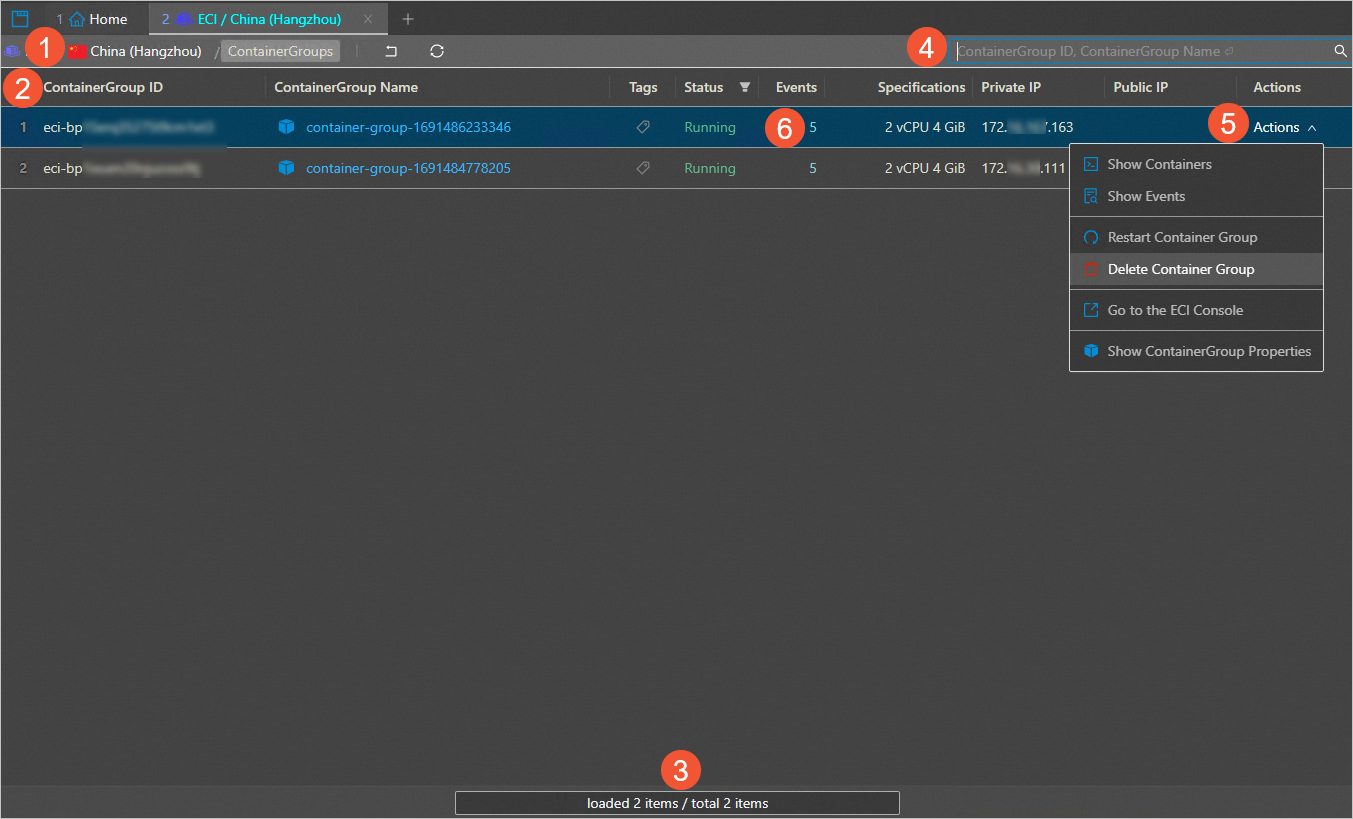You can install Alibaba Cloud Client on an on-premises computer to view, query, or connect to Elastic Compute Service (ECS) instances, elastic container instances, simple application servers, and Alibaba Cloud managed instances. This topic describes how to use Alibaba Cloud Client to manage elastic container instances. You can use Alibaba Cloud Client to view container groups, connect to containers, and manage container groups.
Prerequisites
An Alibaba Cloud account is added to Alibaba Cloud Client. For more information, see Add accounts to Alibaba Cloud Client.
View container groups
On the Home page of Alibaba Cloud Client, click ECI.
On the instance list page, you can view the information of elastic container instances as shown in the following figure.

①: The region of elastic container instances. You can click the region to switch to another region.
②: The list of elastic container instances.
③: The pagination toolbar. You can navigate through pages by using the pagination toolbar.
④: The search box.
Enter a container group ID or container group name in the search box.
Press the Enter key to search for the container group in the current region.
⑤: The Actions menu that provides buttons for performing the following actions:
Restart or delete a container group.
View the details of a container and container group.
Connect to an instance. You need to click the container group ID and then perform operations on the container list page.
Go to the Elastic Container Instance console.
⑥: This section shows the events of elastic container instances.
Connect to a container
On the Home page of Alibaba Cloud Client, click ECI.
In the upper-left corner of the page, select the region where the desired instance resides.
Find the container group and click the container group ID.
Find the container to which you want to connect. In the Actions column, choose .
Specify a command type and click Connect.
If the following information is displayed, the connection is established.

View the properties of a container
On the Home page of Alibaba Cloud Client, click ECI.
In the upper-left corner of the page, select the region where the desired instance resides.
Find the desired container group and click the container group ID.
Find the container whose properties you want to view. In the Actions column, choose .
You can view the basic information of the container, such as the name, image, and command type.
Manage a container group
Restart a container group
On the Home page of Alibaba Cloud Client, click ECI.
In the upper-left corner of the page, select the region where the desired instance resides.
Find the container group that you want to restart. In the Actions column, choose .
In the message appears, check information and then click Restart Container Group.
Delete a container group
On the Home page of Alibaba Cloud Client, click ECI.
In the upper-left corner of the page, select the region where the desired instance resides.
Find the container group that you want to delete. In the Actions column, choose .
In the message that appears, check the instance information and then click Delete Container Group.
View the properties of a container group
On the Home page of Alibaba Cloud Client, click ECI.
In the upper-left corner of the page, select the region where the desired instance resides.
Find the container group whose properties you want to view. In the Actions column, choose .
You can view the basic information of the container group, such as the name, specifications, security group, and vSwitch of the container group.
View the events of an elastic container instance
On the Home page of Alibaba Cloud Client, click ECI.
In the upper-left corner of the page, select the region where the desired instance resides.
You can use one of the following methods to go to the event list page of a container group to view event details:
Method 1: In the list of container groups, find the container group whose events you want to view and click the number in the Events column.
Method 2: In the list of container groups, find the container group whose events you want to view. In the Actions column, choose .
The following figure shows the most recent five events of the elastic container instance. For information about common events and the corresponding solutions, see Custom events of Elastic Container Instance.

References
Alibaba Cloud Client can manage elastic container instances, ECS instances, simple application servers, and Alibaba Cloud managed instances. For more information, see the following topics:
You can configure the settings of Alibaba Cloud Client based on your business requirements. The settings of Alibaba Cloud Client include shortcut key settings and general settings such as language and color theme. For more information, see Configure the settings of Alibaba Cloud Client.